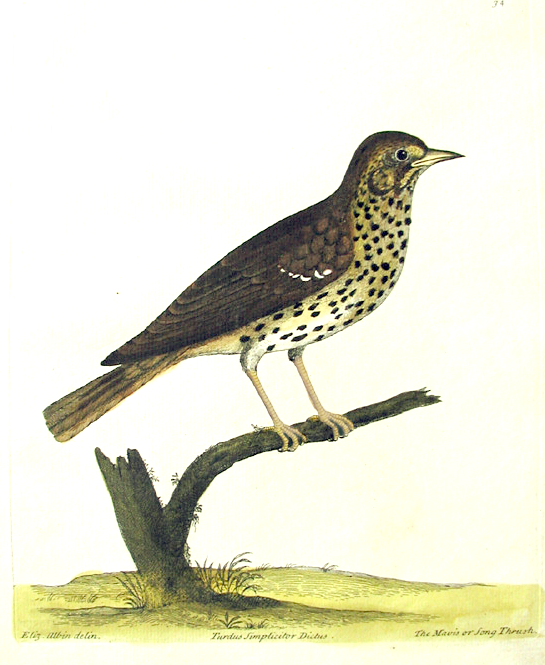


Song Thrush from William Lewin's Birds of Great Britain, 2nd edition 1794-1801.
A Song Thrush perched high up in the willow tree at the bottom of the garden is busy shouting a celebration over his territory. He stops only infrequently throughout the day to look for a bite to eat which allows me to hear the other thrushes around here shouting their applause over their bit of dirt, but none sings quite as well as this one here in the willow tree. The thrush is usually such a gentle, shy and retiring bird, in contrast to its strident jubilant song. It is a song so full of life and vitality that it can cheer the dullest days for, unlike the blackbird, he sings throughout the winter as well as in the nesting months, giving heart to the listener longing for the spring.
Many a morning this winter I have preferred to listen to him rather than the dreary news on the radio while he composes his own melodies, embellishing them, turning them all ways and experimenting in different tone effects, tempos and pitches.
Lately, a blackbird down by the river, having stopped squabbling with a challenger to his territory, has started to compete with my thrush from the top of a poplar tree and it is interesting to compare their songs.
The song thrush and the blackbird are among the finest of the bird world’s musicians and there are even those who say that they can compete with the human species in their musical ability. The composer Antonin Dvorak called birds the true masters of music and certainly the more advanced songs of birds possess all the basic elements of music as we know it — rhythm, tone, harmony and melody.
That extraordinary British naturalist Len Howard says of blackbirds that “their song is much more akin to human music than that of any other species, some of their tunes being in approximately correct classical notation of interval and time signature (using compound and simple time). Each bird appears to try a variety of effect by singing his tunes at different paces, adding embellishments, altering the key, singing in major and minor modes, using staccato and legato. They even try turning the phrases upside down. All these ways of treating a tune are in the human composer’s technique. The blackbird’s delivery is calm and controlled and vibrato is used effectively and with great discrimination.”
One blackbird, Len Howard says, actually composed the opening phrases of the Rondo in Beethoven’s violin concerto and she swears that it was not mimicry.
Of the song thrush, she says they also compose many phrases of different rhythms but they are shorter than the blackbird’s and sung twice or three times consecutively. Some phrases in song, she says, are common to many within the species but each bird composes original songs as well.
Many thrushes and blackbirds contain imitative notes in their songs, not only of other birds but also of any sounds that may take their fancy. It is this imitative ability that proves so useful in improving their songs. Across the whole breadth of the animal kingdom mimicry has been attained only by the bird order passeriformes, parrots and man. Not even man’s closest relatives, the great apes, possess the ability to mimic.
I often compare the songs of the thrush and the blackbird to that most wonderful of our own songbirds, Korimako, the bellbird, and do wonder how much these birds learn off each other for they are all great mimics.
Neither the thrush nor the blackbird can compete with the purity of tone of that single bell–like note of the bellbird, a note which can, of course, vary greatly between bellbirds. On the other hand, the bellbird does not seem to have the inventiveness of the thrush and the blackbird. However, I have heard a starling make a pretty good rendition of the bellbird’s song.


Song Thrush from Eleazar ALBIN's The Natural History of Birds, 1735-50.
| Taxonomy | |
|---|---|
| Kingdom: | Animalia |
| Phylum: | Chordata |
| Class: | Aves |
| Order: | Passeriformes |
| Family: | Muscicapidae |
| Genera: | Turdus |
| Species: | philomelos |
| Sub Species: |
mavis, throstle
Introduced bird
23 cm., 70 g., sexes alike, brown above, buff white underparts, spotted dark brown, yellowish bill, legs pinkish, juvenile rusty brown.
Widespread and common.
Song Thrush
LINK to the Song Thrush NEST Page
Poetry: —
That's the wise thrush; he sings each song twice over,
Lest you should think he never could recapture
The first fine careless rapture!
— Robert Browning
The Darkling Thrush
I leant upon a coppice gate
When Frost was specter gray,
And Winter’s dregs made desolate
The weakening eye of day.
The tangled bine–stems scored the sky
Like strings of broken lyres,
And all mankind that haunted nigh
Had sought their household fires.
The land’s sharp features seemed to be
The Century’s corpse outleant,
His crypt the cloudy canopy,
The wind his death-lament.
The ancient pulse of germ and birth
Was shrunken hard and dry,
And every spirit upon earth
Seemed fervorless as I.
At once a voice arose among
The bleak twigs overhead
In a full–throated evensong
Of joy illimited;
An aged thrush, frail, gaunt, and small,
In blast-beruffled plume,
Had chosen thus to fling his soul
Upon the growing gloom.
So little cause for carolings
Of such ecstatic sound
Was written on terrestial things
Afar or nigh around,
That I could think there trembled through
His happy good–night air
Some blessed Hope, whereof he knew
And I was unaware.
— Thomas Hardy
Lewin, William, Birds of Great Britain, 2nd edition 1794-1801.
Eleazar ALBIN, The Natural History of Birds, 1735-50.
Heather, B., & Robertson, H., Field Guide to the Birds of New Zealand, 2000.
Oliver, W.R.B., New Zealand Birds, 1955.
Sunday, 3 September, 2023; ver2023v1